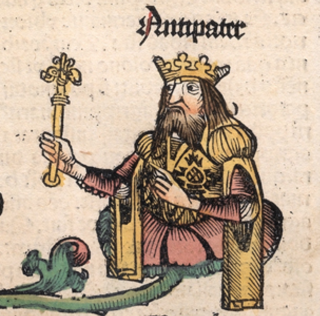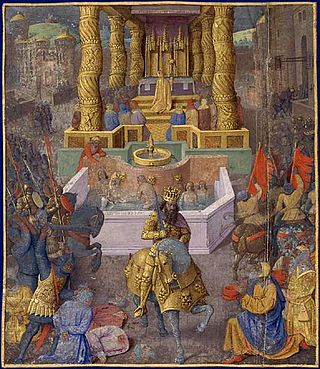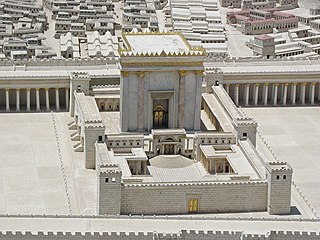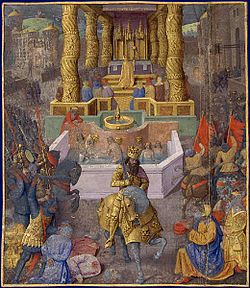This article concerns the period 39 BC – 30 BC.

Herod I or Herod the Great was a Roman Jewish client king of the Herodian Kingdom of Judea. He is known for his colossal building projects throughout Judea. Among these works are the rebuilding of the Second Temple in Jerusalem and the expansion of its base—the Western Wall being part of it. Vital details of his life are recorded in the works of the 1st century CE Roman–Jewish historian Josephus.

Herod Agrippa, also known as Herod II or Agrippa I, was the last Jewish king of Judea. He was a grandson of Herod the Great and the father of Herod Agrippa II, the last known king from the Herodian dynasty. He was acquaintance or friend of Roman emperors and even played crucial roles in internal Roman politics.

The Hasmonean dynasty was a ruling dynasty of Judea and surrounding regions during the Hellenistic times of the Second Temple period, from c. 140 BCE to 37 BCE. Between c. 140 and c. 116 BCE the dynasty ruled Judea semi-autonomously in the Seleucid Empire, and from roughly 110 BCE, with the empire disintegrating, Judea gained further autonomy and expanded into the neighboring regions of Perea, Samaria, Idumea, Galilee, and Iturea. The Hasmonean rulers took the Greek title basileus ("king") as the kingdom became a regional power for several decades. Forces of the Roman Republic intervened in the Hasmonean Civil War in 63 BCE and made it into a client state, marking the decline of Hasmonean dynasty; Herod the Great displaced the last reigning Hasmonean client-ruler in 37 BCE.

Antipater I the Idumaean was the founder of the Herodian Dynasty and father of Herod the Great. According to Josephus, he was the son of Antipas and had formerly held that name.

Aristobulus II was the Jewish High Priest and King of Judea, 66 BCE to 63 BCE, from the Hasmonean dynasty.

Judaea was a Roman province from 6 to 132 CE, which incorporated the Levantine regions of Judea, Samaria and Idumea, extending over parts of the former regions of the Hasmonean and Herodian kingdoms of Judea. The name Judaea was derived from the Iron Age Kingdom of Judah.

John Hyrcanus II, a member of the Hasmonean dynasty, was for a long time the Jewish High Priest in the 1st century BCE. He was also briefly King of Judea 67–66 BCE and then the ethnarch (ruler) of Judea, probably over the period 47–40 BCE.

Antigonus II Mattathias, also known as Antigonus the Hasmonean was the last Hasmonean king of Judea. He was the son of King Aristobulus II of Judea. In 37 BCE Herod handed him over to the Romans for execution, after Antigonus's three-year reign during which he led the Jews' fierce struggle for independence against the Romans.

Herod of Chalcis, also known as Herod Pollio King of Chalcis, Herod V, and listed by the Jewish Encyclopedia as Herod II, was a son of Aristobulus IV, and the grandson of Herod the Great, Roman client king of Judaea. He was the brother of Herod Agrippa I and Herodias and ruled as the king of Chalcis in 41–48 CE.

The Herodian dynasty was a royal dynasty of Idumaean (Edomite) descent, ruling the Herodian Kingdom of Judea and later the Herodian Tetrarchy as a vassal state of the Roman Empire. The Herodian dynasty began with Herod the Great, who assumed the throne of Judea, with Roman support, bringing down the century-old Hasmonean Kingdom. His kingdom lasted until his death in 4 BCE, when it was divided among his sons and daughter as a tetrarchy, which lasted for about 10 years. Most of those tetrarchies, including Judea proper, were incorporated into Judaea Province from 6 CE, though limited Herodian de facto kingship continued until Agrippa I's death in 44 CE and nominal title of kingship continued until 92 CE, when the last Herodian monarch, Agrippa II, died and Rome assumed full power over his de jure domain.
Phasael, was a prince from the Herodian Dynasty of Judea.

Antipater II was Herod the Great's first-born son, his only child by his first wife Doris. He was named after his paternal grandfather Antipater the Idumaean. He and his mother were exiled after Herod divorced her between 43 BC and 40 BC to marry Mariamne I. However, he was recalled following Mariamne's fall in 29 BC and in 13 BC Herod made him his first heir in his will. He retained this position even when Alexander and Aristobulus rose in the royal succession in 12 BC, and even became exclusive successor to the throne after their execution in 7 BC.

The Herodian tetrarchy was a regional division of a client state of Rome, formed following the death of Herod the Great in 4 BCE. The latter's client kingdom was divided between his sister Salome I and his sons Herod Archelaus, Herod Antipas, and Philip. Upon the deposition of Herod Archelaus in 6 CE, his territories were transformed into a Roman province. With the death of Salome I in 10 CE, her domain was also incorporated into a province.

Hasmonean coinage are the coins minted by the Hasmonean kings. Only bronze coins in various denominations have been found; the smallest being a prutah or a half prutah. Two Roman silver denarii are associated with the Hasmoneans; one has the inscription BACCIVS IVDAEAS; with its exact meaning unclear (short for "BASILEOS IUDAEAS", King Judas?). Both show a man thought to be Yehuda Aristobolus bowing before a camel with a palm branch in his hand.
Alexander II, or Alexander Maccabeus, was the eldest son of Aristobulus II, king of Judaea. He married his cousin Alexandra Maccabeus, daughter of his uncle, Hyrcanus II. Their grandfather was Alexander Jannaeus, the second eldest son of John Hyrcanus. Mariamne, the daughter of Alexander and Alexandra, was Herod the Great's second wife and Hasmonean queen of the Jewish kingdom.

The siege of Jerusalem occurred during Pompey the Great's campaigns in the East, shortly after his successful conclusion of the Third Mithridatic War. Pompey had been asked to intervene in a dispute over inheritance to the throne of the Hasmonean Kingdom, which turned into a war between Hyrcanus II and Aristobulus II. His conquest of Jerusalem, however, spelled the end of Jewish independence and the incorporation of Judea as a client kingdom of the Roman Republic.

Herod the Great's siege of Jerusalem was the final step in his campaign to secure the throne of Judea. Aided by Roman forces provided by Marcus Antonius, Herod was able to capture the city and depose Antigonus II Mattathias, ending Hasmonean rule. The siege appears in the writings of Josephus and Dio Cassius.

The Hasmonean Civil War was a civil war between two claimants to the Hasmonean Jewish Crown. What began as an inter-Jewish conflict became a highly decisive conflict that included the Nabataean Kingdom and ended with Roman involvement. This conflict resulted in the loss of Jewish independence.

The Second Temple period in Jewish history began with the end of the Babylonian captivity and the Persian conquest of the Near East in 539 BCE. The Second Temple was then built, and finished around 516 BCE. The conquests of Macedonia under Alexander the Great in 332 BCE saw Judea and the Near East placed under Greek influence during the Hellenistic period; Hellenistic Judaism blended both Greek and Jewish traditions. The Maccabean Revolt of 167–142 BCE was fight a first for Judean autonomy against a suppression of traditional Judaism, and later acquired outright independence under the rule of the Hasmonean family in an independent Hasmonean kingdom. The Hasmoneans would rule until 63 BCE, when they were reduced to client king status as Roman puppets; that too would end in 37 BCE, with King Herod the Great taking control, leading to the Herodian dynasty. Herod's death would lead to both the Herodian Tetrarchy where smaller regions ruled by members of his family, as well as direct Roman control by the governors of Roman Judea. The period would come to an end with the First Jewish–Roman War of 66–73 CE. Jerusalem was conquered in 70 CE, and the Second Temple was destroyed.


















